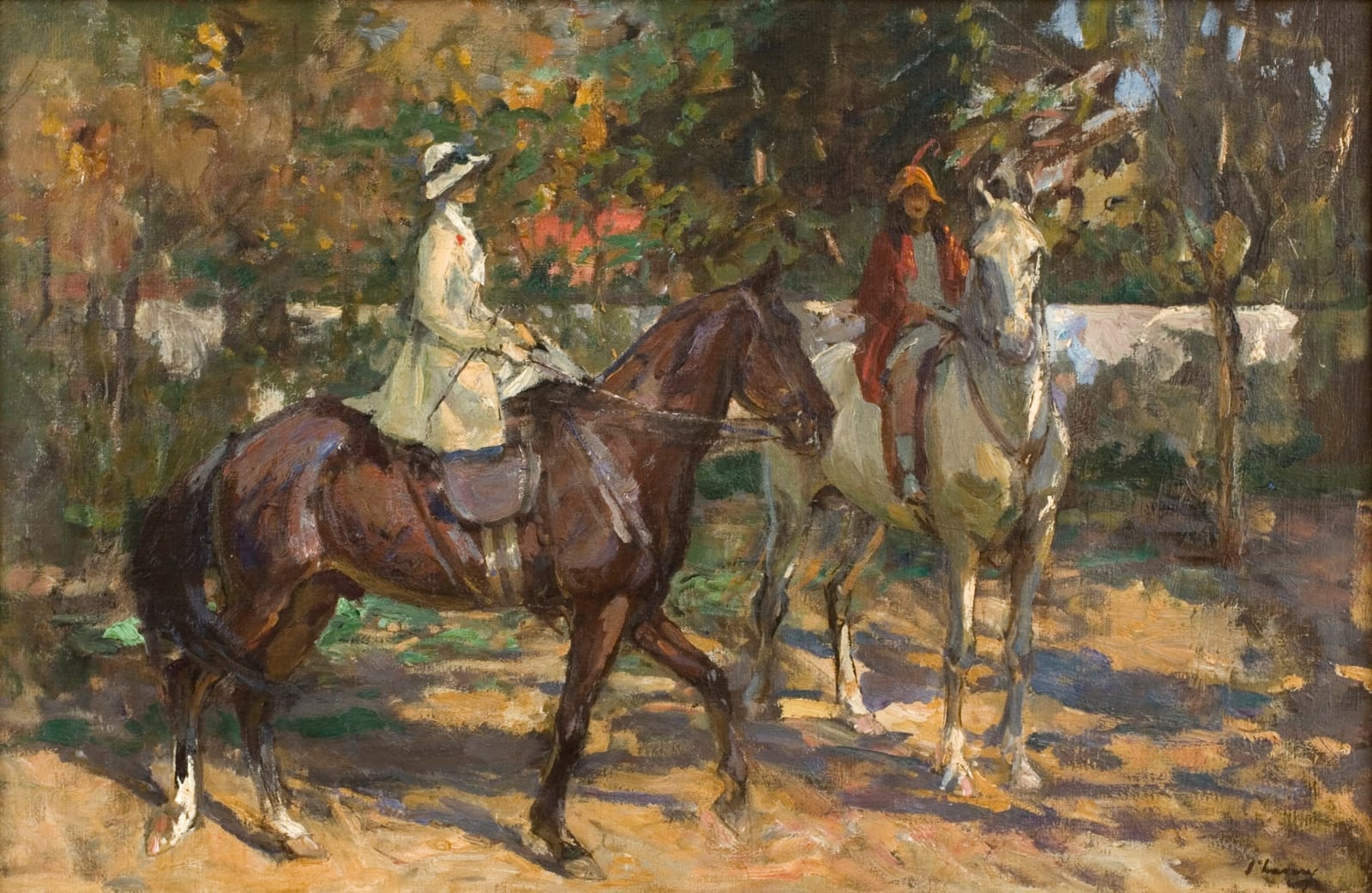Sir John Lavery, RA, RHA, RSA Irish, 1856-1941
Following the purchase of Dar-el-Midfah, his house on Mount Washington, to the south-west of Tangier, Lavery made annual winter pilgrimages to the city. The steep unmade paths around the house made it only accessible by foot or on horseback, and being skilled riders, the artist and his daughter, Eileen, became familiar figures in the motley group of European expatriates. In those troubled early years of the century when kidnappings and raids by local brigands were common, father and daughter were regular participants on pig-sticking forays organized by members of the British Legation – the painter, for one season, being dubbed ‘President’ of the informal Tangier Hunt. Lavery rode a fine nut-brown ‘Barb’ that was at times uncontrollable at these events. This may be one of the horses in the present work.
After 1909, the painter’s North African expeditions included Eileen, now in her late teens, his new wife, Hazel, and her daughter, by her first marriage, the five-year-old Alice Trudeau. This precocious child, despite her natural exuberance, was a frequent model, even though on one occasion, keen to be off, she was overheard saying, ‘isn’t it a pity, Muffie (her mother), that we married an artist’ (Life of a Painter, 1941, p.131). When Hazel and Alice started to accompany him, the painter purchased for his wife, an elderly white battle-steed named ‘Lily-Beau’, that had reputedly once belonged to the Sultan. Unused to temperamental Arab chargers and nervous about the growing unrest in Morocco, Hazel was uncomfortable with the animal and called for its sale, only to discover that her daughter had conceived an affection for it. Despite her mother’s misgivings, ‘Lily-Beau’ was retained as the girl’s pony and her mother paraded to the Kasbah in regal style on a donkey. With Alice’s growing prowess, the horse became a member of the family, being painted in full regalia, in the large family group entitled In Morocco, 1913. (National Gallery of Victoria, Melbourne) This canvas was highly praised when it appeared in Lavery’s retrospective exhibition in 1914 – the critic A Stodart Walker noting that the painter had avoided the ‘dead formalism so long associated with animal painting’ (The Studio, vol LXII, 1914, p.14). PG Konody, writing in The Observer was taken with ‘the pattern of light and shade on the gravel of the wall- enclosed garden’ (The Observer, 7 June 1914) which provides the setting for the picture. However, he noted, it was ‘less broken up’ than was ‘Lavery’s wont’, and in striking this comparison with the artist’s more usual approach, he may perhaps have been thinking of works such as the closely related present example.
More than the Melbourne picture A Morning Ride exemplifies Lavery’s full-blooded Impressionism, in which light and shade fall at random and are not rounded into the ‘pattern’ observed by Konody. At the same time both share a common lineage in an oil sketch showing Alice on her favourite mount, and while the identity of the second rider in the present work remains unknown, the scale of the figure suggests a girl of Alice’s age, rather than her mother or step-sister. A Morning Ride surpasses the sketch in its remarkable atmospheric quality, and in picking out the musculature of the two horses, the tangled foliage and white-washed perimeter wall of the terraces of Dar-el-Midfah, it achieves the spontaneity of Lavery’s most attractive Moroccan garden scenes. The relaxed colonial lifestyle is captured in a lush sunlit arcadia, and in Stodart’s words, ‘the veritable apotheosis of all he feels, knows and thinks of life and colour in Tangier’ is resoundingly achieved.
